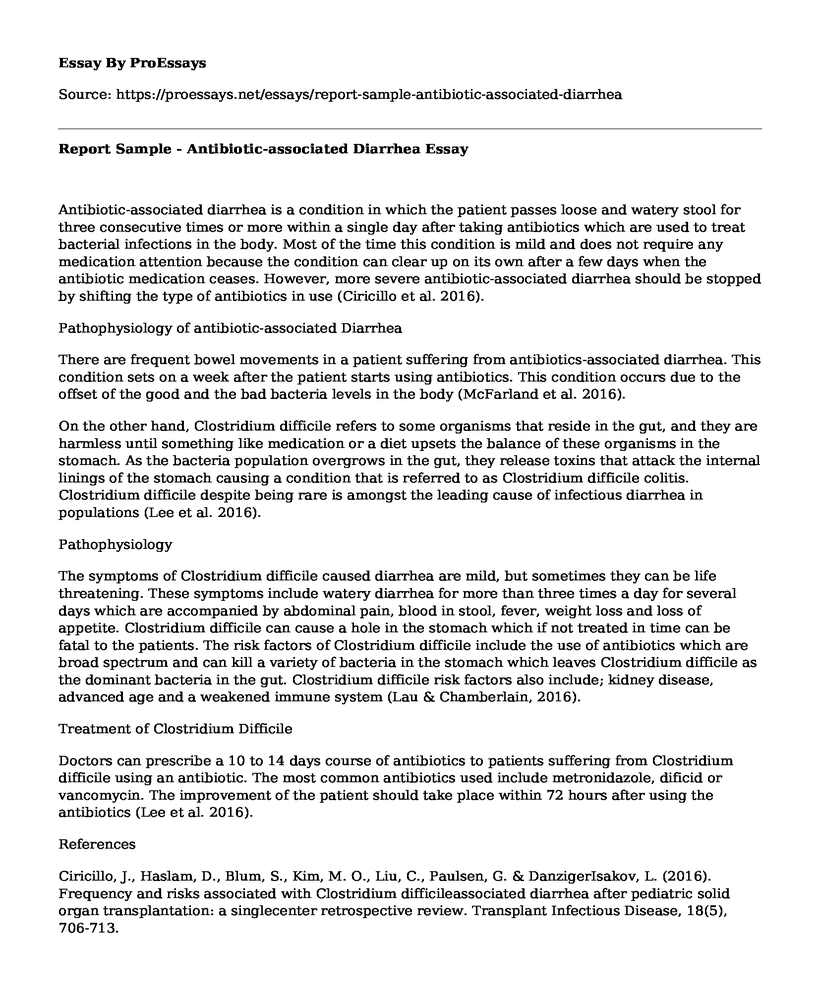Antibiotic-associated diarrhea is a condition in which the patient passes loose and watery stool for three consecutive times or more within a single day after taking antibiotics which are used to treat bacterial infections in the body. Most of the time this condition is mild and does not require any medication attention because the condition can clear up on its own after a few days when the antibiotic medication ceases. However, more severe antibiotic-associated diarrhea should be stopped by shifting the type of antibiotics in use (Ciricillo et al. 2016).
Pathophysiology of antibiotic-associated Diarrhea
There are frequent bowel movements in a patient suffering from antibiotics-associated diarrhea. This condition sets on a week after the patient starts using antibiotics. This condition occurs due to the offset of the good and the bad bacteria levels in the body (McFarland et al. 2016).
On the other hand, Clostridium difficile refers to some organisms that reside in the gut, and they are harmless until something like medication or a diet upsets the balance of these organisms in the stomach. As the bacteria population overgrows in the gut, they release toxins that attack the internal linings of the stomach causing a condition that is referred to as Clostridium difficile colitis. Clostridium difficile despite being rare is amongst the leading cause of infectious diarrhea in populations (Lee et al. 2016).
Pathophysiology
The symptoms of Clostridium difficile caused diarrhea are mild, but sometimes they can be life threatening. These symptoms include watery diarrhea for more than three times a day for several days which are accompanied by abdominal pain, blood in stool, fever, weight loss and loss of appetite. Clostridium difficile can cause a hole in the stomach which if not treated in time can be fatal to the patients. The risk factors of Clostridium difficile include the use of antibiotics which are broad spectrum and can kill a variety of bacteria in the stomach which leaves Clostridium difficile as the dominant bacteria in the gut. Clostridium difficile risk factors also include; kidney disease, advanced age and a weakened immune system (Lau & Chamberlain, 2016).
Treatment of Clostridium Difficile
Doctors can prescribe a 10 to 14 days course of antibiotics to patients suffering from Clostridium difficile using an antibiotic. The most common antibiotics used include metronidazole, dificid or vancomycin. The improvement of the patient should take place within 72 hours after using the antibiotics (Lee et al. 2016).
References
Ciricillo, J., Haslam, D., Blum, S., Kim, M. O., Liu, C., Paulsen, G. & DanzigerIsakov, L. (2016). Frequency and risks associated with Clostridium difficileassociated diarrhea after pediatric solid organ transplantation: a singlecenter retrospective review. Transplant Infectious Disease, 18(5), 706-713.
Lau, C. S., & Chamberlain, R. S. (2016). Probiotics are effective at preventing Clostridium difficile-associated diarrhea: a systematic review and meta-analysis. International journal of general medicine, 9, 27.
Lee, C. H., Steiner, T., Petrof, E. O., Smieja, M., Roscoe, D., Nematallah, A., ... & Ropeleski, M. J. (2016). Frozen vs fresh fecal microbiota transplantation and clinical resolution of diarrhea in patients with recurrent Clostridium difficile infection: a randomized clinical trial. Jama, 315(2), 142-149.
McFarland, L. V., Ozen, M., Dinleyici, E. C., & Goh, S. (2016). Comparison of pediatric and adult antibiotic-associated diarrhea and Clostridium difficile infections. World journal of gastroenterology, 22(11), 3078.
Cite this page
Report Sample - Antibiotic-associated Diarrhea. (2021, Apr 12). Retrieved from https://proessays.net/essays/report-sample-antibiotic-associated-diarrhea
If you are the original author of this essay and no longer wish to have it published on the ProEssays website, please click below to request its removal:
- Should Continuing Nursing Education Be Mandatory for All Nurses? Essay
- Syllabus Course on the Introduction to Fields of Addiction Review Paper
- Health Disparities Are Often Experienced by Minority Communities Within a Society Essay
- Research Paper on Regulating Nurses & Midwives
- Antitrust Laws in U.S. Generic Drug Industry: Unfair Market Competition & Price Hikes - Essay Sample
- Essay Example on Stop Smoking & Radon Pollution: Reduce Health Hazards
- Paper Example on Nursing: My Passion to Protect the Healthcare System







